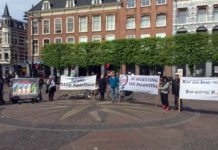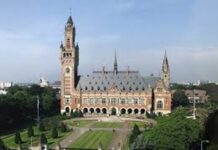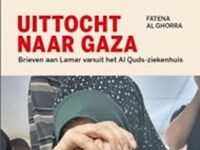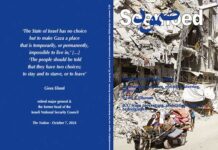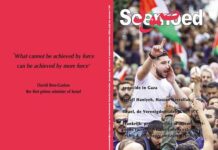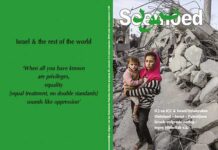Sharif Abdel Kouddous
Drop Site News / March 24, 2025
Filed hours before his killing in an Israeli airstrike, journalist Hossam Shabat describes the resumption of Israel’s scorched earth campaign in his hometown of Beit Hanoun.
Hossam Shabat is dead. I am beyond rage and despair as I write these words. The Israeli military bombed his car this morning as he was traveling in Beit Lahia. Videos fill my screen of his body lying on the street, carried to the hospital, grieved by his colleagues and loved ones. These are the kinds of tragic scenes Hossam himself would so often document for the world. He was an exemplary journalist: brave, tireless, and dedicated to telling the story of Palestinians in Gaza.
Hossam was one of a handful of reporters who remained in northern Gaza through Israel’s genocidal war. His ability to cover one of the most brutal military campaigns in recent history was almost beyond comprehension. He bore witness to untold death and suffering on an almost daily basis for seventeen months. He was displaced over twenty times. He was often hungry. He buried many of his journalist colleagues. In November, he was wounded in an Israeli airstrike. I still can’t believe I am referring to him in the past tense. Israel obliterates the present.
When I contacted Hossam in November to ask him to write for Drop Site News, he was enthusiastic. “Greetings habibi. May God keep you. I am very happy to have this opportunity,” he wrote. “There are so many ideas, scenes, stories.”
His first dispatch for Drop Site News was a searing account of a vicious mass expulsion campaign by the Israeli military in Beit Lahia that forced thousands of Palestinian families to flee one of the last remaining shelters in the besieged town:
Some of the wounded fell on the road with no hope of getting treatment. “I was walking with my sister in the street,” said Rahaf, 16. She and her sister were the sole survivors in their family of an earlier airstrike that killed 70 people. “Suddenly my sister fell due to the bombing. I saw blood pouring from her, but I couldn’t do anything. I left her in the street, and no one pulled her out. I was screaming, but no one heard me.”
His writing was lyrical and arresting. I struggled to translate and edit his pieces—to do them justice, to convey his emotive use of Arabic into something relatable in English. In the typical editorial see-saw back and forth of finalizing a piece, I would often return to him with clarifications and questions, asking him for additional details and direct quotes. He was always quick to respond despite his extraordinary circumstances.
In January, Hossam filed a piece about the three days between when the “ceasefire” deal was announced and when it was scheduled to be implemented, a period when Israel escalated its bombing campaign across Gaza:
They targeted the al-Falah school; they bombed an entire residential block in Jabaliya; they killed families, like the Alloush family, whose bodies have not yet been recovered and still lie under and over the rubble. The children I saw that night appeared happy but they were no longer living, their faces frozen in a mix of smiles and blood.
In early December, when writing a preamble to one of his articles, I asked him to confirm his age. “Hahaha. I’m young. 24,” he wrote. Then moments later he clarified: “Actually, I haven’t turned 24 yet. I’m 23.” I told him he was young in age only, but in experience he was old (it sounds better in Arabic). “I’m really tired,” he responded. “I swear I have no strength left. I can’t find a place to sleep. I’ve been displaced 20 times.” He continued: “Did you know that I am the only one in my family who lives alone in the north?” Last month, during the “ceasefire,” he was reunited with his mother for the first time in 492 days.
In October, the Israeli military placed Hossam and five other Palestinian journalists on a hit list. At the time, he said it felt like he was “hunted.” He called on people to speak out using the hashtag #ProtectTheJournalists: “I plead everyone to share the reality about Journalists in order to spread awareness about the real plans of the Israeli occupation to target journalists in order to impose a media blackout. Spread the hashtag and talk about us!”
In December, after the Israeli military killed five journalists in an airstrike on their vehicle, I messaged to check in on him.
“Our job is only to die,” he responded. “I hate the whole world. No one is doing anything. I swear I’ve come to hate this job.” About his surviving colleagues he wrote, “We’ve started saying to each other: “Ok, whose turn is it?…Our families consider us already martyred.”
When Israel resumed its scorched earth bombing last week, I messaged again to check in on him. He responded with one word: “Death.”
Throughout it all, Hossam would message with ideas for stories, or just to relay what was happening in the north. In his messages and voice notes, he often somehow still managed to be warm and funny—a kind of rebellion against the death all around him.
After the “ceasefire” went into effect, he returned to his hometown of Beit Hanoun on the northeastern edge of Gaza. Hardly a structure was left standing, but he was determined to stay and document the destruction.
He messaged me late Sunday night, just hours before he was killed. He had been forced to leave his hometown of Beit Hanoun on the day of Israel’s renewed assault last week and was forcibly displaced yet again—this time to Jabaliya. We had agreed on him writing a piece about the attack last week and what he had witnessed.
“Habibi,” he wrote. “I miss you.” I asked him what the situation was like in Jabaliya. “Difficult,” he said.
He sent his piece, and I read through it, sent my follow-up questions. He only answered one before going offline. I messaged him again as soon as I woke up this morning. I didn’t yet know that he had been killed.
What you are about to read is Hossam’s last article. I translated it through tears.
— Sharif Abdel Kouddous


